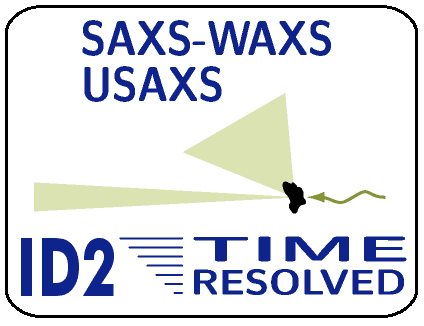Overview
The beamline ID02 is primarily a combined (ultra) small-angle and wide-angle scattering instrument. The high brilliance of an undulator source is exploited to probe the microstructure and nonequilibrium dynamics of soft matter and related systems from a few Angstroms to micron scale, and down to sub-millisecond time range.
The scientific applications of the ID02 beamline can be broadly divided into three domains; (1) soft condensed matter, (2) noncrystalline structural biology, and (3) interdisciplinary areas of soft matter, biology, and nanoscience. Soft matter studies most often involve probing the equilibrium and nonequilibrium microstructure, while the structural biology works are largely centered around the structure-function relationship. In the interdisciplinary topics, the hierarchical structures of a variety of self-assembled exotic systems are elucidated.
Some of the techniques used in softmatter research can be directly applied to industrial research and development problems.
Beamline upgrade (07/2013 to 07/2014):
After nearly two decades of successful operation, ID02 was designated as one of the ESRF upgrade beamlines (TRUSAXS). A major upgrade during 2013-2014 has led to a significant enhancement of the available scattering vector range and resolution. Improvements of source properties and detector performance, new scientific challenges together with accumulated experience in beamline operation have contributed to this new design.
The upgrade comprised a novel focusing scheme chosen to preserve the brilliance of the source, a new detector vacuum tube of 34 m long and 2 m in diameter which houses a suit of detectors optimised for different applications. The focusing optics allows moderate adjustment of beam size at the sample position or detector according to the experimental requirements (e.g. reduction of radiation damage, increase of resolution, etc.).
All three techniques, SAXS, WAXS and USAXS, are combined to a single instrument with sample-to-detector distance variable from 0.8 m to 31 m. The new beamline offers the unique possibility of time resolved USAXS experiments with two dimensional detectors. This has opened up new opportunities for probing transient processes and oriented systems in the ultra small-angle range. In addition, the coherence of the beam is exploited to perform ultra small-angle X-ray photon correlation spectroscopy (USA-XPCS) down to the sub-millisecond range.
ESRF EBS upgrade (12/2018 to 03/2020):
Following the ESRF EBS upgrade, the beamline came online soon after the beam was delivered for experiments in March 2020. Prior to the restart, the installation and software integration of the Eiger2-4M SAXS/USAXS detector, and the new data reduction pipeline, DAHU, were completed. The upgrade significantly improved the performance of XPCS with 30 times more coherent flux and the fast Eiger-500k detector. In addition, the monochromator was refurbished with improved cooling and a new polished channel-cut Si-111 crystal.
Principal Techniques
-
Time-resolved small- & wide- angle X-ray scattering (combined SAXS/WAXS)
-
High resolution ultra small-angle X-ray scattering (USAXS)
-
Ultra small-angle X-ray photon correlation spectroscopy (USA-XPCS)
All setups involve a monochromatic, highly collimated, and intense beam in the pinhole configuration. Combined (U)SAXS and WAXS provide a wide q-range (0.001 nm-1 to 50 nm-1 at 0.1 nm wavelength) with high angular resolution. Both SAXS and WAXS employ area detectors, and the SAXS detector distance can be varied from 0.8 m to 31 m. The q-resolution at 31 m is about 0.0004 nm-1 for a wavelength of 1 Å , and a beamsize and detector resolution of 40 µm. With the highest degree of collimation, q-resolution down to 0.00015 nm-1 can be obtained. The tight collimation and widely separated optical components provide a lower background. Measured intensities are usually normalized to an absolute intensity scale.
Main changes since 2020 are described in Ref. [1]. The technical reference for experiments carried out before 2020 is still Ref. [2]. Recent improvements of XPCS are reported in Ref. [3]. More design details are provided in Refs. [4] and [5]. Some representative scientific applications can be found in Ref. [6].
[1] T. Narayanan, M. Sztucki, T. Zinn, J. Kieffer, A. Homs-Puron, J. Gorini, P. Van Vaerenbergh and P. Boesecke, J. Appl. Cryst., 55, 98 (2022); https://doi.org/10.1107/S1600576721012693
[2] T. Narayanan, M. Sztucki, P. Van Vaerenbergh, J. Le´onardon, J. Gorini, L. Claustre, F. Sever, J. Morse and P. Boesecke, J. Appl. Cryst., 51, 1511 (2018); https://doi.org/10.1107/S1600576718012748.
[3] W. Che´vremont, T. Zinn and T. Narayanan, J. Synchrotron Rad., 31, 65 (2024); https://doi.org/10.1107/S1600577523008627.
[4] P. Van Vaerenbergh, J. Le´onardon, M. Sztucki, P. Boesecke, J. Gorini, L. Claustre, F. Sever, J. Morse, and T. Narayanan, AIP Conf. Proc., 1741, 030034 (2016); https://doi.org/10.1063/1.4952857
[5] J. Léonardon, P. Van Vaerenbergh, T. Narayanan, et al., Design of a new detector tube for wide, small and ultra small-angle X-ray scattering, MEDSI Conf. Proc. (2014).
[6] T. Narayanan, Recent advances in synchrotron scattering methods for probing the structure and dynamics of colloids, Adv. Colloid Interf. Sci., 325, 103114 (2024); https://doi.org/10.1016/j.cis.2024.103114.
Further Information
- Schematic beamline layout
- Characteristics of the X-ray source
- Beam characteristics
- Practical and technical details about the beamline can be found in the Beamline Description, e.g.
- Overview of detectors for SAXS/WAXS and USAXS
- Sample environments
- Procedures for data acquisition and online reduction
- Scientific and industrial applications
- PDF list of ID02 publications




